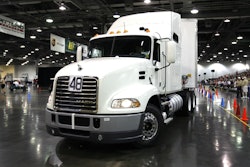At a facility tour for media at the company’s Huntsville Engine Plant in Huntsville, AL, Navistar International Corporation announced that it has delivered approximately 17,000 vehicles to U.S. and Canadian customers in the past quarter.
During a tour of the Huntsville facility, which is the sole Navistar engine plant in North America, supplying products to seven Navistar truck plants in the U.S. and Canada, editors saw production engines being built, as well as pre-production MaxxForce 15 liter engines being assembled. The MaxxForce 15 is slated to enter full production sometime next year.
“Like our other manufacturing facilities, our Huntsville engine plant is operating in full production mode and shipping several hundred engines each week to our truck and bus assembly locations,” says Daniel Ustian, chairman, president and chief executive officer at Navistar. “To date, we have built and shipped more than 15,000 EPA-compliant 2010 vehicles and we continue to build more than 100 EPA2010 MaxxForce 13 engines every day.”
“For us, this is about differentiation and leadership,” adds said Michael Cerilli, vice president, North American Truck Marketing, Navistar. “Clearly Navistar’s emissions path is different. But we’re leading this industry in a number of ways beyond simple product categories. And we see that quantified in the 28,000 EPA 2010 orders we have received, the 17,000 trucks shipped through the fourth quarter, over 10,000 orders for ProStar trucks integrated with our MaxxForce 13 engine and more than 1,000 orders for our new medium-duty TerraStar model which will begin shipping to dealers and customers this month.”
Ustian adds that despite the bickering with competitors over SCR and EGR technologies to meet EPA 2010 emissions regulations, he is pleased with how well Navistar’s EGR-only solution has been received in the marketplace. “The response has been about what we expected,” he says. “We don’t see our SCR competitors going at each other. They’re all coming after us. Because they’re worried. We have something they can’t have – not something they don’t have: Something they can’t have for a long time. So we take all of this as a compliment.”
Expanding on that theme, Ramin Younessi, Navistar group vice president, product development and strategy, noted that Navistar will soon submit technical data for the company’s next generation of low-emissions diesel engines to the EPA for certification. “We’ll be able to show better fuel economy with this technology at .02 grams of NOx,” he notes. “Naturally, we won’t put that engine into production until we have to. That will be as far out as we can make it: We don’t want to make changes until we have to. So we will wait until our credits expire: and we’ve got at least a couple of years left there. But we’re going to get everything certified soon so that everyone understands we have a solution that works and will be available when the time comes.”
“We take heat for using credits,” Ustian adds. “But the rest of the story – that gets overlooked – is that Navistar has been beating EPA standards for years. We earned those credits. And, of course, everyone is using credits. But our competitors use them to try and convince people we’re not kosher now. That’s why we sued EPA and CARB: because credits are being used as a marketing tool. And we’ve shown that you can by-pass SCR technology either by ignoring the DEF light on the dash, or get rid of it by pouring water in DEF tank – with no degradation of performance. And our position is very simple: When SCR truck is not in compliance with emissions regulations, something should happen as a result.”













